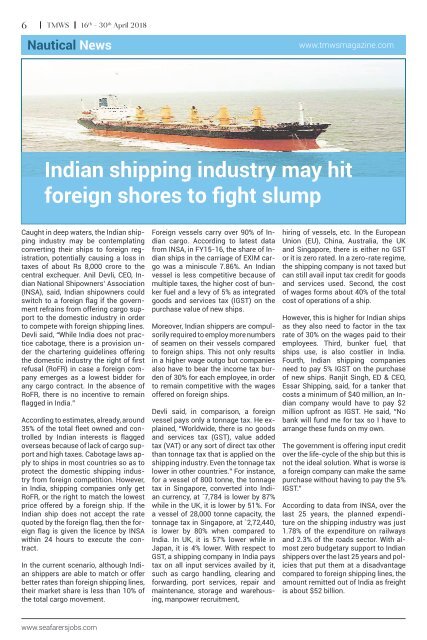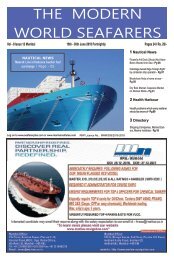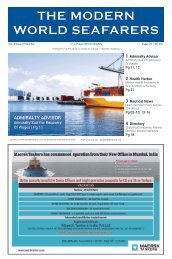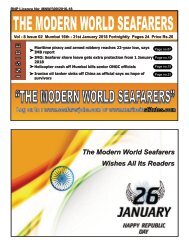Create successful ePaper yourself
Turn your PDF publications into a flip-book with our unique Google optimized e-Paper software.
6 TMWS 16 th - 30 th April 2018<br />
Nautical News<br />
www.tmwsmagazine.com<br />
Indian shipping industry may hit<br />
foreign shores to fight slump<br />
Caught in deep waters, the Indian shipping<br />
industry may be contemplating<br />
converting their ships to foreign registration,<br />
potentially causing a loss in<br />
taxes of about Rs 8,000 crore to the<br />
central exchequer. Anil Devli, CEO, Indian<br />
National Shipowners’ Association<br />
(INSA), said, Indian shipowners could<br />
switch to a foreign flag if the government<br />
refrains from offering cargo support<br />
to the domestic industry in order<br />
to compete with foreign shipping lines.<br />
Devli said, “While India does not practice<br />
cabotage, there is a provision under<br />
the chartering guidelines offering<br />
the domestic industry the right of first<br />
refusal (RoFR) in case a foreign company<br />
emerges as a lowest bidder for<br />
any cargo contract. In the absence of<br />
RoFR, there is no incentive to remain<br />
flagged in India.”<br />
According to estimates, already, around<br />
35% of the total fleet owned and controlled<br />
by Indian interests is flagged<br />
overseas because of lack of cargo support<br />
and high taxes. Cabotage laws apply<br />
to ships in most countries so as to<br />
protect the domestic shipping industry<br />
from foreign competition. However,<br />
in India, shipping companies only get<br />
RoFR, or the right to match the lowest<br />
price offered by a foreign ship. If the<br />
Indian ship does not accept the rate<br />
quoted by the foreign flag, then the foreign<br />
flag is given the licence by INSA<br />
within 24 hours to execute the contract.<br />
In the current scenario, although Indian<br />
shippers are able to match or offer<br />
better rates than foreign shipping lines,<br />
their market share is less than 10% of<br />
the total cargo movement.<br />
Foreign vessels carry over 90% of Indian<br />
cargo. According to latest data<br />
from INSA, in FY15-16, the share of Indian<br />
ships in the carriage of EXIM cargo<br />
was a miniscule 7.86%. An Indian<br />
vessel is less competitive because of<br />
multiple taxes, the higher cost of bunker<br />
fuel and a levy of 5% as integrated<br />
goods and services tax (IGST) on the<br />
purchase value of new ships.<br />
Moreover, Indian shippers are compulsorily<br />
required to employ more numbers<br />
of seamen on their vessels compared<br />
to foreign ships. This not only results<br />
in a higher wage outgo but companies<br />
also have to bear the income tax burden<br />
of 30% for each employee, in order<br />
to remain competitive with the wages<br />
offered on foreign ships.<br />
Devli said, in comparison, a foreign<br />
vessel pays only a tonnage tax. He explained,<br />
“Worldwide, there is no goods<br />
and services tax (GST), value added<br />
tax (VAT) or any sort of direct tax other<br />
than tonnage tax that is applied on the<br />
shipping industry. Even the tonnage tax<br />
lower in other countries.” For instance,<br />
for a vessel of 800 tonne, the tonnage<br />
tax in Singapore, converted into Indian<br />
currency, at `7,784 is lower by 87%<br />
while in the UK, it is lower by 51%. For<br />
a vessel of 28,000 tonne capacity, the<br />
tonnage tax in Singapore, at `2,72,440,<br />
is lower by 80% when compared to<br />
India. In UK, it is 57% lower while in<br />
Japan, it is 4% lower. With respect to<br />
GST, a shipping company in India pays<br />
tax on all input services availed by it,<br />
such as cargo handling, clearing and<br />
forwarding, port services, repair and<br />
maintenance, storage and warehousing,<br />
manpower recruitment,<br />
hiring of vessels, etc. In the European<br />
Union (EU), China, Australia, the UK<br />
and Singapore, there is either no GST<br />
or it is zero rated. In a zero-rate regime,<br />
the shipping company is not taxed but<br />
can still avail input tax credit for goods<br />
and services used. Second, the cost<br />
of wages forms about 40% of the total<br />
cost of operations of a ship.<br />
However, this is higher for Indian ships<br />
as they also need to factor in the tax<br />
rate of 30% on the wages paid to their<br />
employees. Third, bunker fuel, that<br />
ships use, is also costlier in India.<br />
Fourth, Indian shipping companies<br />
need to pay 5% IGST on the purchase<br />
of new ships. Ranjit Singh, ED & CEO,<br />
Essar Shipping, said, for a tanker that<br />
costs a minimum of $40 million, an Indian<br />
company would have to pay $2<br />
million upfront as IGST. He said, “No<br />
bank will fund me for tax so I have to<br />
arrange these funds on my own.<br />
The government is offering input credit<br />
over the life-cycle of the ship but this is<br />
not the ideal solution. What is worse is<br />
a foreign company can make the same<br />
purchase without having to pay the 5%<br />
IGST.”<br />
According to data from INSA, over the<br />
last 25 years, the planned expenditure<br />
on the shipping industry was just<br />
1.78% of the expenditure on railways<br />
and 2.3% of the roads sector. With almost<br />
zero budgetary support to Indian<br />
shippers over the last 25 years and policies<br />
that put them at a disadvantage<br />
compared to foreign shipping lines, the<br />
amount remitted out of India as freight<br />
is about $52 billion.<br />
www.seafarersjobs.com
















